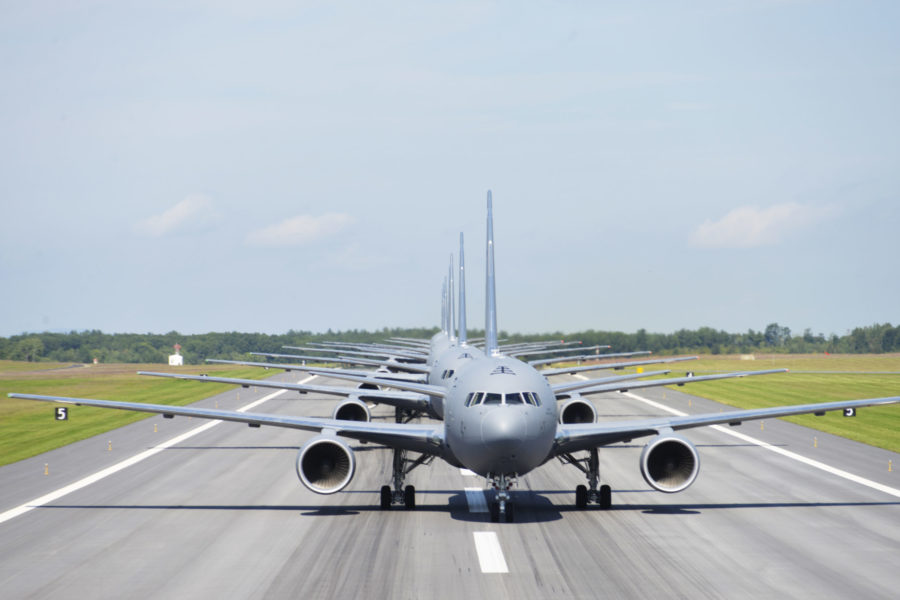The Air Force probably won’t pursue some exotic approach for the KC-Y and KC-Z tranches of the service’s aerial refueling tanker modernization plan, Chief of Staff Gen. Charles Q. Brown Jr. said. The KC-46, “tweaked” with upgrades, can likely do the job, he reported.
At a March 25 fiscal 2023 budget rollout briefing, Air Force Secretary Frank Kendall said, “I want to be very transparent about this: I think that there’s still a possibility of a competition out there” for the KC-Y and KC-Z programs, “but as we’ve looked at our requirements, the likelihood of a competition has come down.”
Brown, meeting with defense reporters on April 12, said he concurred with Kendall’s comment.
“I do somewhat agree with him,” Brown said. Going through “the developmental piece” of a new approach to the KC-Y “may take more time [and] more money,” and this outlay is probably unnecessary because the KC-46, despite its deficiencies, “is doing fairly well,” Brown said. He added that in most scenarios, the KC-46 provides a better than one-for-one capability replacement for the KC-135.
“So part of the question is, do we go straight to the KC-Z?” Brown said.
The last three heads of Air Mobility Command have speculated that the KC-Z might be a significant departure from the modified-airliner approach taken with the KC-135, KC-10, and, overseas, with the KC-30 and KC-767 tankers. They have speculated that it might possibly be a stealthy platform that could operate inside an enemy’s air defense zone.
Brown brushed that notion aside, however, saying the Next Generation Air Dominance family of systems, intended to operate inside an enemy integrated air defense system (IADS), will have “the range to go where it needs to go” and that an escort tanker is probably not needed. Brown specifically said, “I wouldn’t call [KC-Z] an escort tanker.”
Still, the Air Force is reassessing the KC-Z, which in initial plans would have replaced the KC-10 with a comparably sized tanker larger than the KC-135 or KC-46.
Lockheed Martin has a partnership with Airbus to offer an Americanized KC-30 Multi-Role Tanker Transport to the Air Force, under the name “LMXT,” that would incorporate a number of new technologies, including probable autonomous boom operation. Lockheed Martin is specifically targeting the KC-Y contest, the initial requirements for which could call for a longer-ranged platform. The MRRT is about 40 percent larger than the KC-46.
Brown wondered if the KC-Z requirement is “still valid, based on the threat—based on what we know [about] how the KC-46 is doing? I think it’s worth looking at [whether] Z [should be] the way we originally thought it was going to be.”
Studies undertaken during the last administration’s Air Force acquisition executive, Will Roper, explored wither the boom operator could be eliminated on tankers and replaced with an autonomous lidar remote-sensing system, Brown said. Noting that cars are being offered with hands-free driving, Brown wondered, “Could you do that on a tanker? It potentially could change what the tanker requirements are.”
In the grand scheme of things, though, “I’d say a tanker’s a tanker, depending on how big it is, how much gas it carries, where it can go, where it can land,” Brown said. “And those are the things we do have to think about. And how you protect it, and what communications suite it has on it.”
The KC-Y and Z tankers would differ from the KC-46 in having “additional self-protection” capabilities and serve as a communication node, he noted.
Brown also said Air Mobility Command has been quietly operating KC-46s in Europe “for the last month or so” and planned to keep them there through about April 22. Gen. Mike Minihan, AMC commander, “did that so they’d have some operational deployment and wring out some things,” Brown said, noting that “when you deploy, you learn things … Crawl, walk, run—and they’re running.” The KC-46s are “able to do quite a bit of stuff to support the operation in Europe right now,” Brown asserted.
The KC-46s are not yet considered operational due to continued deficiencies with the Remote Vision System that allows the boom operator to see what’s happening at the back end of the aircraft. But the airplanes are certified for a secondary mobility mission and can do air refueling if needed. The KC-46 has been certified to refuel about 70 percent of the aircraft planned for it.
Asked why aerial refueling capacity is no longer the liability it was described as three years ago, Brown acknowledged that the end of overwatch and strike operations in Iraq and Afghanistan has relieved some of the tanker burden. But he also said AMC has “new tools” that allow the tanker inventory to be more efficiently tasked and managed.
“When I was the air component commander for CENTCOM,” Brown said, “we were still doing tanker planning on a white board.” When U.S. Transportation Command and AMC “came in and said, ‘We want to take some tankers,’” Brown declined because “I don’t have the analysis and data to be able to show that I can let these tankers go home.” The subsequent introduction of planning tools fixed that situation, he said.
“By using the data, I think we’re smarter about how we’re going to be able to do things,” he said.
